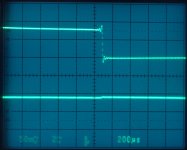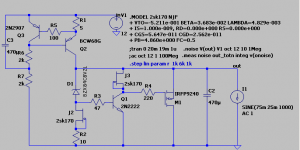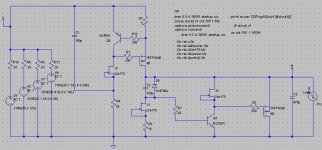jwb said:What's a practical way to measure the noise on these high-end regulators? We're talking about total integrated noise from 10-100kHz in the range of 1uV or less. You would need some kind of very quiet pre-amp to see it on a scope, right?
Among other things, I have used Denis Colin's noise amp which was in AX -- without tripping on their copyright it's a pair of 2SK170's (or an LSK389) with feedback to the source degeneration resistor. The drain is coupled to an AD797 serving as an inverting amplifier. I use an LT1028 since my supply of DIP AD797's is drying up.
I've also used the SSM2019 -- perhaps Jan can opine -- this is a very low noise dual opamp -- he used the SSM2017 in his article which verified the performance of the Jung regulators, but that device has been obsoleted.
Any of these devices need the coupling capacitor to be discharged (or precharged) so you don't fry the front end of your amplifier.
Other devices you can use -- a Tektronix 7A22n or 5A22n plug-in, the Tektronix ADA400A Differential Amplifier etc. I troll the T&E section of EBay all the time, entering "noise" in the search engine.
This is my Colin LN Amp -- it's good down to about 2nV/Hz^.5
An externally hosted image should be here but it was not working when we last tested it.
ikoflexer said:
Used .5 ohms ESR for all caps in the simulation, and no ESL. What value would you recommend I use for ESL? Thanks.
Edit: BTW, here's another result using the lm4562.
Various cap manufacturers spec their ESL from around 5nH for ultra
small size to over 30nH for large can types, then add some more for
pcb trace to cap.
I've been using 10nH for OP cap.
It certainly has a significant effect on the simulated load step
response, especially when using fast edge rates.
cheers
T
In this Cornell-Dubilier app note, they say the following:
Typical series inductance values of radial and screw-terminal capacitors are about 1-2 nH/mm terminal spacing.
janneman said:
jwb,
The RdsOn of the MOSFET is of no significance here, because the FET is not used fully on. It has no impact at all on any of the regulation parameters. It always has the full Vout across it and whatever current is necessary to maintain the output at the set value.
Jan Didden
Jan, in my implementation it shunts about 80% of the 200mA CCS current at all time. The rest goes to the load presented by the 2 phono channels. Some goes to the Zener and BJT of course. Can this be of any consequence? VGS is 3.3-3.4V.
salas said:
Jan, in my implementation it shunts about 80% of the 200mA CCS current at all time. The rest goes to the load presented by the 2 phono channels. Some goes to the Zener and BJT of course. Can this be of any consequence? VGS is 3.3-3.4V.
syn08 answered me that question in another thread. He said that except than in switching applications, in a linear regulator we will not drive a Mosfet (either in series or shunt) to conditions that will make this characteristic relevant. So jwb, no worries about less regulation due to more rds(on) with the Mosfets you have. I only subjectively favor TO240 IRF Mosfets in the shunt which happen to be relatively low RDS(on) too, I don't know if there may be some electronics explanation.
0.03 Ohm flat from 20Hz-20kHz I find splendid, since the output capacitor and cabling to my phono can easily mask that. I especially like the flat behavior.
jwb said:No I haven't listened to it yet. Transient performance isn't bad either. The top trace is the load signal into a 62R load (about a 25mA load step), and the bottom trace is the regulator output.
Great!
- Status
- This old topic is closed. If you want to reopen this topic, contact a moderator using the "Report Post" button.
- Home
- Amplifiers
- Power Supplies
- Best low noise regulator?


